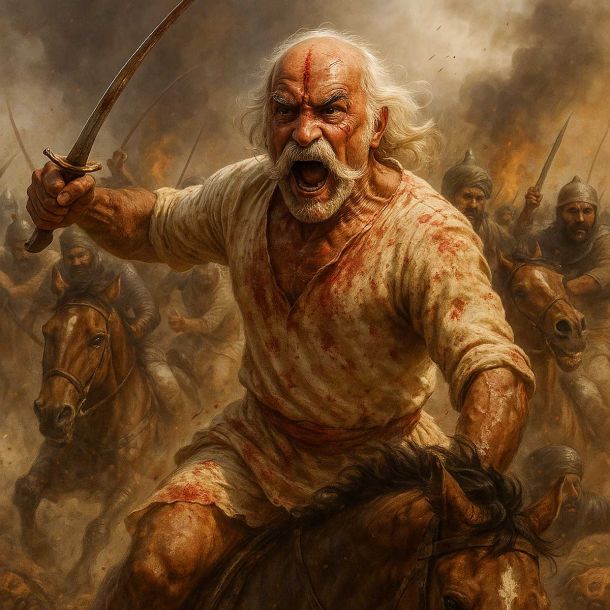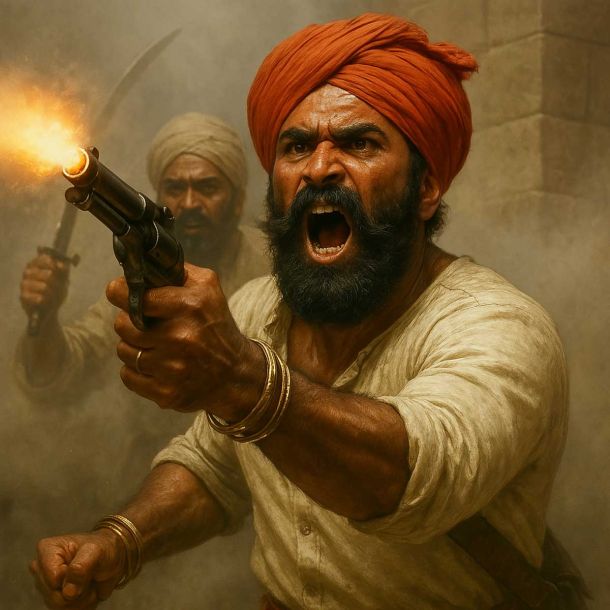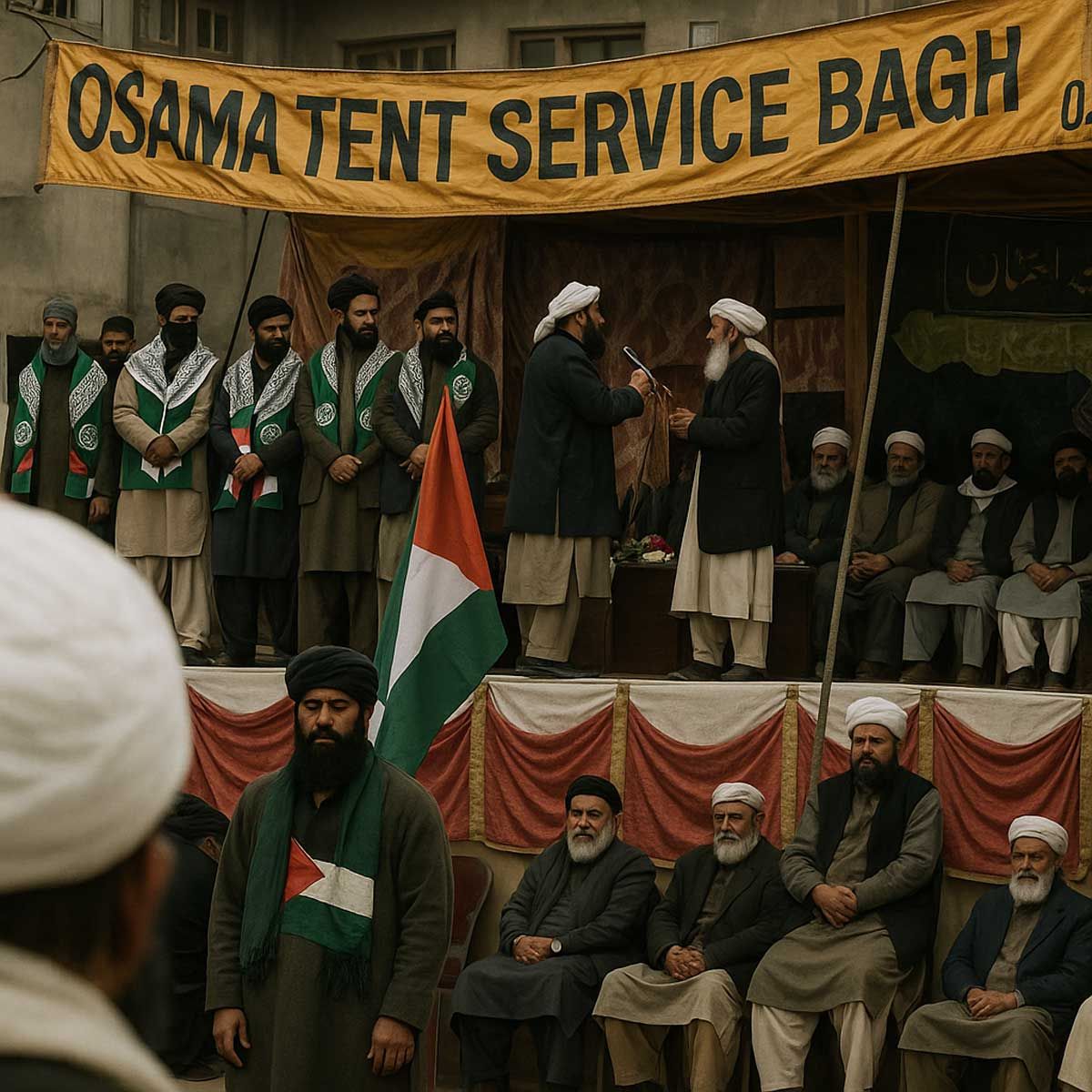Sanatan Articles
Satyaagrah
Written on
Satyaagrah
Written on
Satyaagrah
Written on
Satyaagrah
Written on
Satyaagrah
Written on
JOIN SATYAAGRAH SOCIAL MEDIA
"History is the propaganda of the victors": Qutub Minar or Dhurva Stambha - 24-petalled architectural lotus flower is purely a Hindu concept, an ancient Hindu Astronomical Observatory on which lifeless insertions of Quranic inscriptions are forced

Felice Beato was a British photographer of Italian origin. He travelled through India after the so-called ‘mutiny’ or uprising of the Indian army against their British officers in 1857. Beato took photographs of sites associated with the uprsing, as well as more general photographs of the most important monuments of the cities he visited, as in this example.
|
This photograph shows a colonnade of pillars that make up the north side of the Quwwat-ul-Islam Mosque, south of Delhi. Built between 1193 and 1199, this is the earliest extant mosque in India. It was built on the site of the captured Rajput citadel of Qila Rai Pithora as a symbol of victory by Qutbuddin Aibak (d. 1210), the military commander of the Afghan Ghurid dynasty who defeated the last Hindu ruler of Delhi and sought to establish Islam in this newly acquired territory.
The mosque consists of a simple rectangle enclosing a central quadrangle measuring 43.2 by 33 metres. Three sides of the mosque have pillared colonnades built using the remains of 27 demolished Hindu and Jain temples, a fact recorded on the main eastern entrance to the mosque. The Hindu and Jain iconography on the pillars is clearly visible, showing lotus flowers, scrolling foliage and kalasa or vessels overflowing with flowering creepers – a Brahmanical motif signifying abundance and overflowing prosperity.
|
Victory Minaret
Beato's view of the lower portion of the Qutb Minar ('Victory Minaret'). The Qutb Minar is a red sandstone tower which stands approximately 240 feet high and was built during the early 13th century by the ruling Delhi sultanate. The intricate calligraphic bands of script which run beneath the balconies contain verses of the Quran. The tower is recognised as one of the earliest Muslim monuments in India and was probably erected to celebrate a victory.
|
The Arches and Iron Pillar near the Kutub Minar
Photograph of the Arches and Iron Pillar near the Kutub Minar. This fourth-century pillar, framed by an early-thirteenth-century arch, has been a curiousity to scientists as it appears never to rust. The arches are amongst the first example of the pointed arch in Indian archtecture, and similarly Beato may have been amongst the first to photograph this perspective of the Quwwat-ul-Islam mosque, located near the Qutb Minar.
Qutub Minar or Dhurva Stambha
In Arabic “Qutub” literally means ‘axis’, ‘pivot’ or ‘pole’. Qutb can refer to celestial movements and used as an astronomical term or a spiritual symbol. So the term ‘Qutub Minar’ signifies an astronomical Tower. That was how it was described to Sultan and later referred to in court correspondence. In course of time the name of Sultan Qutubuddin came to be unwittingly associated with the Qutub Tower leading to the misleading assertion that Qutubuddin built the Qutub Minar. – by Prof. M.S. Bhatnagar, Ghaziabad (India) June 10, 1977
This unique and unprecedented diagram (Fig 1) is that of the so-called QUTB MINAR. It uncovers the truth and knocks out all confusing, contradictory and fabricated explanations given by chroniclers of the Moslem Kings of Delhi and some archaeologists about the history and purpose of this lofty stone-tower.
A visit which fostered the present research:
In 1961, some college students went with me to the Qutb Minar and engaged an official guide, an M.A. in History. Questions and answers between our party and the Sarkari guide are given below in brief:
Q. What was the purpose of building this ‘MINAR’ ?
A. Victory Tower.
Q. Whose victory over whom ?
A. Md. Ghori’s victory over Rai Pithaura (Prithvi Raj)
Q. Where ?
A. At Tarain near Panipat.
Q. Why is the Victory Tower at Delhi ?
A. Do not know.
One gentleman from the visitors, a Lecturer in History in the University of Delhi, took up the threat and answered:
The Victory Tower was commenced by Ghori because Delhi became his capital.
Q. Objection, Sir! Ghori never had his capital at Delhi. His capital was at Ghazni. What logic is there in building the Victory Tower in Delhi ?
A. Silence.
Q. Even if the Minar was commenced by Ghori, its name ought to have been ‘GHORI MINAR’ and not ‘QUTB MINAR’. Why is it called ‘Qutb Minar’ ?
A. It was probably Qutubuddin Aibak, slave of Ghori, who laid the foundation of the minar for his master.
Q. If this is true, what made him choose Delhi as the site for the Victory Tower?
A. Delhi was the capital of Qutbuddin Aibak.
Q. It is said that the building of the Minar was commenced during the life time of Ghori. When Ghori was alive, the question of his slave’s capital being at Delhi does not arise. After the death of Ghori, Qutbuddin was crowned at Sultan at Lahore. He ruled from Lahore and not Delhi and ultimately died at Lahore. His capital was at Lahore ? Why did he build the Victory Tower at Delhi ?
A. Silence.
Somebody from the audience asserted that the Minar was not a victory tower but a ‘Mazina’ (Muezzin’s Tower in mosque) attached to ‘Quwwat-ul-Islam Mosque’.
Q. The word ‘Quwwat-ul-Islam Mosque’ is unknown to contemporary history of India. This word was coined by Sir Saiyid Ahmad Khan in the first part of the nineteeth century. Do not be surprised to know that the name ‘QUTB MINAR’ too, is not known to Indian History. It is also a recent fabrication. If, for the sake of argument, we take it for granted that the minar is a muezzin’s tower, the mosque assumes primary importance and the tower secondary, but unfortunately the mosque, as you see it, is in complete ruins. How do you account for the mosque of primary importance to be in ruins and the muezzin’s tower, a building of no consequence, to be standing in full majesty ?
A. No Answer.
‘Masjid & Mazina’ with regard to the Qutb Minar is a “COCK & BULL STORY”. The so called Qutb Minar and the ruined Jama Masjid close by cannot be ascribed to the same builder. The Qutb Minar is a much older tower.
|
Quranic inscriptions on the Minar
The Quranic inscriptions on the Minar are forced and lifeless insertions between forceful and beautiful frieze-bands of the pure HINDU DESIGN. To consider the minar of Moslem origin from the Quranic inscriptions would be labelling a non-Muslim as a Mussalman because circumcision has been forced on him.
The Minar is in fact the Dhurva Stambha or the central observation tower of an ancient Hindu Astronomical Observatory. Fig. 1 is based on observation from a two seater aeroplane made to hover over the top of the DHRUVA STAMBHA. The tower looks like a 24-petalled lotus flower (Fig. 2), each petal representing an “HORA”, i.e., an hour on a 24-hour dial (Fig. 3). Vertical projection lines drawn from the mid points of stone-flutings on the top of each storey of the tower to the horizontal plane at its base create a lotus flower similar to what can be seen from the sky over the top of the tower – bottom fig. 1.
The 24-petalled architectural lotus flower is purely a Hindu concept. It cannot be attributed to any Moslem king from dry parts of Western Asia where lotuses do not grow.
You are the proud possessor of the ‘LOTUS’ projection of the DHRUVA STAMBHA which is the result of original thinking, perseverance and expense. Such a projection was neither drawn nor conceived by any architect or archaeologist in the past. Let any body come forward and challenge the statement. Now, you can reasonably silence all those who believe the DHRUVA STAMBHA to be a production of Md. Ghori or Qutbuddin Aibak. Sultans associated with this ‘Minar’ defiled its casing, reversed stones bearing human or animal figures and inserted Arabic Inscriptions. These Sultans can, of course, be praised for not making any claim that they built the ‘Minar’. No body has left any inscription asserting that he started the Minar.
|
ORIGIN DHRUVA STAMBA
The township adjoining the Kutub Minar is known as Mehrauli. That is a Sanskrit word Mihira-awali. It signifies the town- ship where the well known astronomer Mihira of Vikramaditya’s court lived along with his helpers, mathematicians and technicians. They used the so-called Kutub tower as an observation post for astronomical study. Around the tower were pavilions dedicated to the 27 constellations of the Hindu Zodiac.
Kutubuddin has left us an inscription that he destroyed these pavilions. But he has not said that he raised any tower. The ravaged temple was renamed as Kuwat-ul-Islam mosque.
Stones dislodged from the so-called Kutub Minar have Hindu images on one side with Arabic lettering on the other. Those stones have now been removed to the Museum. They clearly show that Muslim invaders used to remove the stone- dressing of Hindu buildings, turn the stones inside out to hide the image facial and inscribe Arabic lettering on the new frontage.
Bits of Sanskrit inscriptions can still be deciphered in the premises on numerous pillars and walls. Numerous images still adorn the cornices though disfigured.
The tower is but a part of the surrounding structures. It is not that while the temples around are earlier Hindu buildings there was sufficient space left in between for Kutubuddin to come and build a tower. Its very ornate style proves that it is a Hindu tower. Mosque minarets have plane surfaces. Those who contend that the tower was meant to call the Muslim residents to prayer have perhaps never tried to go to the top and try to shout to the people below. Had they done so they would have found out for themselves that no one on the ground can hear them from that height. Such absurd claims have been made to justfy Muslim authorship of earlier Hindu buildings.
Another important consideration is that the entrance to the tower faces north and not the west as is enjoined by Islamic theology and practice.
At either side of the entrance is the stone lotus flower emblem which also proves that it was a Hindu building. The stone flowers are a very important sign of the Hindu author- ship of mediaeval buildings. Muslims never use such flowers on the buildings they construct.
|
The Hindu title of the tower was Vishnu Dhwaj (i.e. Vishnu’s standard) alias Vishnu Stambh alias Dhruv Stambh (i.e., a polar pillar) obviously connoting an astronomical observation tower. The Sanskrit inscription in Brahmi script on the non-rusting iron pillar close by proclaims that the lofty standard of Vishnu was raised on the hillock named Vishnupad Giri. That description indicates that a statue of the reclining Vishnu initiating the creation was consecrated in the central shrine there which was ravaged by Mohammad Ghori and his henchman Kutubuddin. The pillar was raised at the command is an ancient Hindu king who had made great conquests in the East and the West.
The seventh storey had actually a statue of the four-faced Brahma holding the Vedas at the beginning of creation. Above Brahma was a white marble canopy with gold bell patterns laid in it. The top three stories were in mle. They were ravaged by iconoclastic muslims who detested the Brahma statue. The Muslim raiders also destroyed the reclining Vishnu image at the bottom.
The iron pillar was the Garud Dhwaj alias Garud Stambh, i.e, the sentinel post of the Vishnu temple.
On one side was an elliptical enclave formed by 27 Nakshatra (constellation) temples. A gigantic redstone, ornate gate- way led to the sacred enclave known as Nakshatralaya. Therefore gateway is traditionally known as Alaya-Dwar.
Cunningham twists the traditional Hindu name to fraudulently ascribe the great doorway to Sultan Allauddin though Allauddin himself makes no such claim.
By Allauddin’s time the surroundings were totally crumbling ruins. Why would Allauddin want to raise an ornate gigantic gatewwa(of the Hindu orange colour) leading from nowhere to nowhere ?
The theory propounded by interested Muslims that it is a muazzin’s tower is a motivated lie. No muazzin would even for a day adept a job where he has to climb and unclimb five times a day a flight of 365 narrowing, curving steps in the dark confines of the tower. He is bound to fall and die through sheer exhaustion.
The arched gateway of the adjoining so-called Kuwat-ul-Islam mosque is in no way different from the ornate archways of temples in Gujarat. The frieze patterns on this building too. The frieze patterns on this building too show signs of tampering proving that Muslim conquerors transposed stones at random to ease their conscience in readying earlier temples for use as mosques.
References:
 Support Us
Support Us
Satyagraha was born from the heart of our land, with an undying aim to unveil the true essence of Bharat. It seeks to illuminate the hidden tales of our valiant freedom fighters and the rich chronicles that haven't yet sung their complete melody in the mainstream.
While platforms like NDTV and 'The Wire' effortlessly garner funds under the banner of safeguarding democracy, we at Satyagraha walk a different path. Our strength and resonance come from you. In this journey to weave a stronger Bharat, every little contribution amplifies our voice. Let's come together, contribute as you can, and champion the true spirit of our nation.
 |  |  |
| ICICI Bank of Satyaagrah | Razorpay Bank of Satyaagrah | PayPal Bank of Satyaagrah - For International Payments |
If all above doesn't work, then try the LINK below:
Please share the article on other platforms
DISCLAIMER: The author is solely responsible for the views expressed in this article. The author carries the responsibility for citing and/or licensing of images utilized within the text. The website also frequently uses non-commercial images for representational purposes only in line with the article. We are not responsible for the authenticity of such images. If some images have a copyright issue, we request the person/entity to contact us at This email address is being protected from spambots. You need JavaScript enabled to view it. and we will take the necessary actions to resolve the issue.
Related Articles
- How Nehru had laid blue print of Indira Gandhi inheriting his PM post
- Reality of Britishers who tortured, brutalized Indian women and threw them into sexual slavery
- “A true soldier needs both military and spiritual training”: Note of ₹1 lakh came during the Azad Hind govt of Netaji where there was no picture of Mahatma Gandhi but the picture of Subhash Chandra Bose printed and issued by Azad Hind Bank
- Aurangzeb banned Diwali 350 years ago, Courts and governments are just following Mughal ruler
- Kartar Singh Sarabha - The Freedom fighter who was Hanged at the age of 19 and inspired Bhagat Singh
- “It is not the honor that you take with you, but the heritage you leave behind”: Greek historian Megasthenes' Indica provides a historical account of ancient India, offering glimpses into its geography, society, governance, religion, economy, and culture
- The Residue of Islamism - Hindu Society Under Siege
- Khudiram Bose - The symbol of valiance and death-defying youth, an orphan at 7 to hanging by the British at 18
- Ram Prasad Bismil, Tribute To The Fearless Freedom Fighter And Poet
- Renowned Archaeologist KK Mohammed confirms, '27 temples were demolished to build Quwwat-ul-Islam Mosque near Qutub Minar in Delhi, hiding truth is a mistake': Remnants of temples, Lord Ganesha temple found
- Plea for a Perspective: The Story of Islamic Imperialism in India
- "Copyright? Copy RIGHT: Steal ideas, steal facts but do not steal words": Did you know the Greek version of Trojan Horse at Troy from Odyssey was an adaptation of the original Indian version of the Trojan White Elephant from Brihatkatha, a Sanskrit play
- History, tainted by biases, conceals the valor of Hemu—a Hindu king & military genius in medieval India, orchestrating 22 victories, he reshaped history at the Battle of Panipat, his strategic brilliance defied odds, leaving indelible mark on the warfare
- Operation Polo: When India annexed Hyderabad from the Nizam and Razakars, the suppression of Hindus and the role of Nehru
- Queen Victoria to her Viceroy, “Though the Muhammadans’ cow-killing is made the pretext for the agitation, it is in fact, directed against us, who kill far more cows for our army, than the Muhammadans"





















